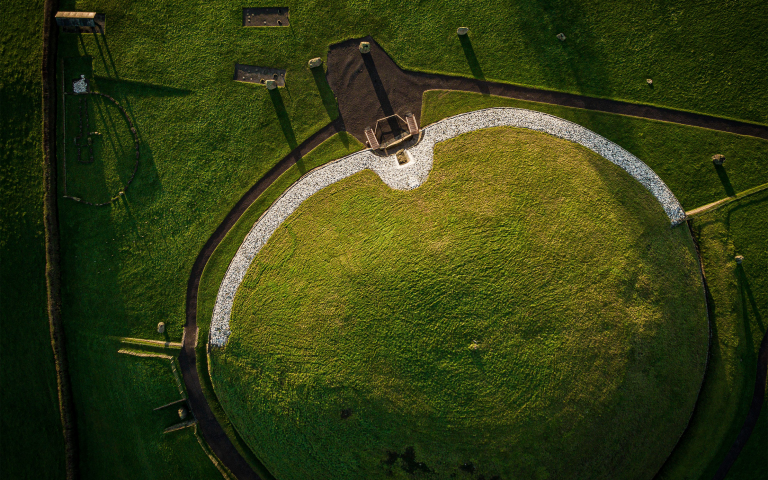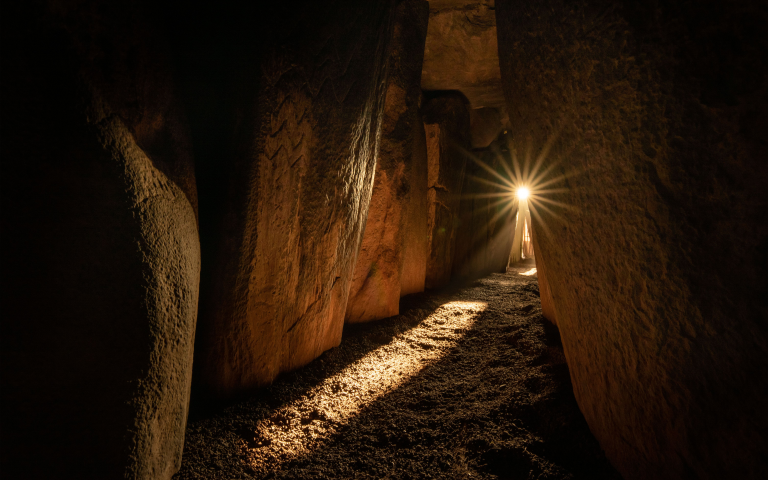Discovery in UNESCO passage tomb points to Neolithic Irish dynasty
18 June 2020
Evidence of an elite adult male conceived through a socially sanctioned incestuous relationship during the Neolithic period has been discovered in Ireland’s largest passage tomb, finds a new study involving UCL and Trinity College Dublin.

The research, published in Nature, reveals evidence of a man thought to belong to a political or religious elite family. The remains were identified in New Grange, a 5,000 year-old passage tomb that sits within the UNESCO monumental site of Brú na Bóinne.
Co-author on the study, Dr Thomas Kador (UCL Arts & Sciences), said: “Across the archaeological, historical and ethnographic spectrum incestuous unions tend to be shunned as a social taboo with the exception of a relatively small number of cases that we know about, such as the Inca Empire and Ancient Egypt. We know that where they are the prerogative of the royal elite, they are primarily concerned with concentrating power within one family/kin group.”
“We believe this implies a level of social organisation and hierarchy that may have emerged against a backdrop of rapid maritime colonisation, and which may also explain the large scale and sophisticated monuments that were constructed during the Neolithic period.”
Genetic sequencing revealed that the individual’s relatives were buried in other Irish passage tombs over 100 km away. This points to a powerful social elite at the top of Irish Neolithic society; which archaeologists believe is associated with the construction of large scale prehistoric monuments.
Dr Lara Cassidy (Trinity College Dublin), first author on the study, said: “It seems what we have here is a powerful extended kin-group, who had access to elite burial sites in many regions of the island for at least half a millennium.”
The researchers sequenced 44 whole genomes from Irish Neolithic people, alongside relevant ancient genomes. These were merged with an ancient dataset to allow for more detailed analysis of population structure and estimation of inbreeding.
In addition, all major Irish Neolithic funerary traditions were sampled: court tombs, portal tombs, passage tombs, Linkardstown-type burials and natural sites.
Overall, the researchers observed no increase in inbreeding during the Neolithic period in Ireland, indicating that communities maintained sufficient size and communication to avoid mating with 5th degree relatives or closer. However, the remains of an elite adult male were a single extreme outlier within New Grange passage tomb.
The male was buried within the most ornate chamber in the tomb with specialised ritual inventory, and winter solstice solar alignment that would have been viewed only by a select few.

Professor Dan Bradley (Trinity College Dublin), last author on the study, said: “The prestige of the burial makes this very likely a socially sanctioned union and speaks of a hierarchy so extreme that the only partners worthy of the elite were family members.”
The nature and distribution of political power in Neolithic Europe remains poorly understood. During the period, many societies began to invest heavily in monument-building, suggesting an increase in social organisation. The scale and sophistication of megalithic architecture along the Atlantic seaboard (along Portugal, Spain, France, UK and Ireland) is particularly impressive, culminating in the great passage tomb complexes.
This new study supports previous evidence that an incoming (maritime) migration event in the centuries after 4000 BC, most likely originating from or linked to the Western Mediterranean, may have brought in new ideas and systems. There is wide evidence to suggest that the arrival of agriculture in Britain and Ireland was assisted by this maritime migration.
Dr Kador said: “Apart from the shared genetics as a consequence of maritime migration, we can see some shared funerary traditions, through the megalithic tombs, and material culture such as pottery. But the key question is to what degree these ‘colonists’ brought their societal structure with them or whether the social hierarchy identified in Ireland is a local development?”
Remarkably, the findings of prehistoric burial mounds and a social sanctioned incestuous relationship investigated in the study strongly resonate with Irish mythology and literature first recorded in the 11th century AD.
Dr Kador concluded: “In Irish mythology there is a tradition associating the tombs of the Boyne Valley with incestuous relationships among ancient royals and deities and it is striking how these stories resonate with our findings. Irish folklore and literary scholars have long suggested that these stories, first recorded in the middle ages date back to a longstanding oral tradition. However, nobody would have assumed that such traditions could stretch back to the Stone Age.”
The research was carried out in collaboration with colleagues from National University of Ireland, Galway, University College Cork, University of Cambridge and Queen’s University Belfast. It was funded by Science Foundation Ireland, Wellcome Trust and Irish Research Council, Government of Ireland.
Links
Image
- Image 1: Newgrange, covering more than an acre, has a reconstructed front wall.Credit: Ken Williams
- Image 2: At Newgrange, the winter solstice sunrise illuminates the inner chamber with a blast of light. Credit: Ken Williams
Media contact
Natasha Downes
- tel: +44 20 3108 3844
- E: n.downes [at] ucl.ac.uk
 Close
Close

